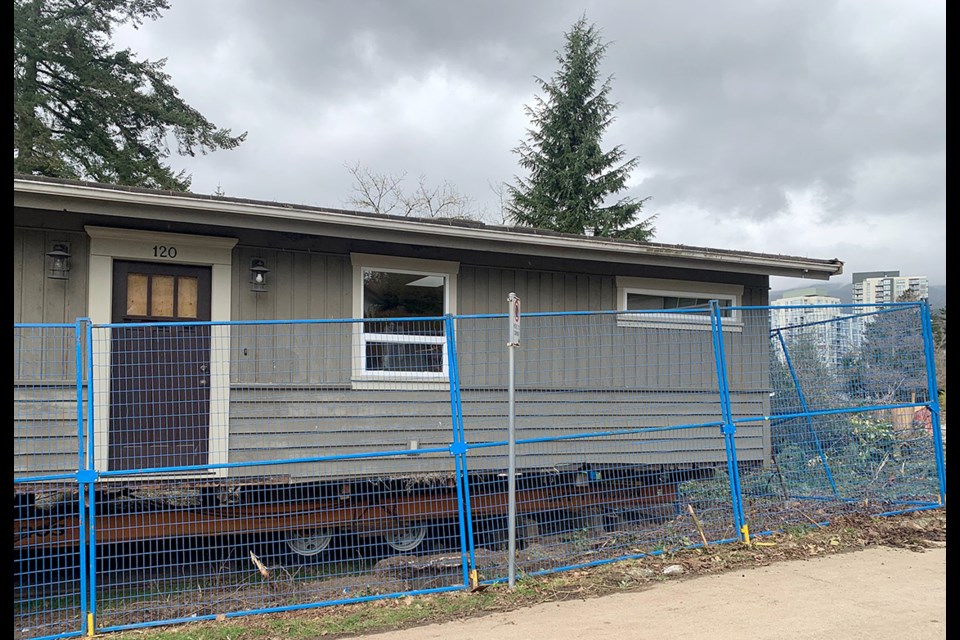The transformation of a Port Moody neighbourhood will help create new, affordable homes for a First Nations community on the Sunshine Coast.
Glyn Lewis, of Renewal Development, said he’s reached an agreement with Wesgroup Properties to move 10 homes from the old Coronation Park neighbourhood to the shíshálh Nation near Sechelt.
The first two homes are scheduled to be moved across Port Moody and Coquitlam overnight April 2 to be loaded onto a barge in the Fraser River April 3 for transport to Selma Park, south of Sechelt.
Once site preparation is completed — including the construction of basements for possible use as secondary suites — the homes will be trucked to their final destinations and made ready for occupancy, likely by the end of September.
The rest of the homes will be similarly transported over the next several weeks.
Each home will be equipped with a GPS tracker so their journey can be followed on Renewal Development’s website.
Lewis said it’s likely the largest ever house reclamation project in British Columbia’s history.
"Nothing of this scale has been done before."
Renewal Development previously moved a house from Coquitlam’s Blue Mountain neighbourhood to Upper Gibsons and a little yellow schoolhouse from Vancouver’s Kitsilano neighbourhood to the Squamish Nation’s Xwemelch’stn Reserve in North Vancouver where it recently reopened as a children’s education centre.
Lewis said those were pilot projects, dry-runs to work out the challenges of bringing together disparate parties and navigate the myriad permitting processes required to make such large-scale moves happen.
The plan to save 10 of the 59 mid-century homes that would otherwise have been demolished as Wesgroup transforms the 14.8-acre Coronation Park into Inlet District, a dense urban mixed-use neighbourhood of six residential high-rises up to 31- storeys, three-six-storey residential buildings and a four-storey office building, began more than a year ago.
Lewis said he approached Wesgroup with his idea to put the $35,000 the company budgeted to demolish each home toward saving them instead; all the homes were assessed for their structural integrity and suitability to be moved with roughly 15 identified for their relocation potential.
He then connected with the shíshálh Nation which sent representatives to Port Moody to see the homes for themselves and agreed to acquire 10 of them.
“It was months and months of feasibility studies and budget assessments,” said Lewis, adding various grants and subsidy programs will also help reduce the cost of the homes between 30 to 70 per cent would it would cost the shishalh Nation to build them new.
Renovation work to upgrade heating systems and make the homes more energy efficient once they’re in place will be done by local contractors and trades people from the shishalh Nation, furthering their economic impact to that community.
Dean Johnson, Wesgroup’s vice president of development, said the company didn’t hesitate to help give the homes a second life.
“Wesgroup is always looking for ways to reduce construction waste and enhance the sustainability of our developments,” he said in a statement.
shíshálh Nation Chief Lenora Joe said her community’s goal is to provide homes for its members on Nation lands, adding she hopes the partnerships to create that housing will pave the way for other Indigenous Nations to follow their lead.
Jeremy Nickel said his company is up to the task of moving so many homes in a short period of time.
Since it was founded in 1956, Nickel Bros. has transported more than 12,000 homes and has a team of experts at its new headquarters in Maple Ridge to secure permits required from municipal and provincial departments and obtain approvals from utility companies and emergency services.
Port Moody Mayor Meghan Lahti said the massive relocation project could become a template for future such efforts as other areas of the city redevelop.
She said once the first few homes have been moved, staff will translate the process into a draft policy to encourage the relocation and repurposing of homes that would otherwise be torn down.
Lewis said he hopes there will be lots of eyes on the parade of homes being transported from Port Moody up the Sunshine Coast, not only from spectators along the roads and shorelines keen to observe such a spectacle but also local and provincial government officials wrestling with issues like demolition waste, carbon emissions and housing affordability as well as developers looking to promote sustainability and affordability.
“I think a lot of developers and municipalities will look to this and ask how they can do this too,” Lewis said, adding with 2,700 homes torn down every year in the Lower Mainland, the potential positive impact of saving and repurposing some of them is huge.
“This is incredibly ambitious,” he said. “This is the right thing to do.”
How to watch the houses being moved
The first two houses, at 120 Windsor and 104 Edinburgh, will begin their journey to the Sunshine Coast at about 11 p.m., April 2.
They'll arrive at Ioco Road at about 11:50 p.m.
- 12:30 – Turning from Barnet Highway onto Mariner Way
- 01:30 – Turning onto Como Lake
- 02:30 – Turning onto Blue Mtn
- 03:00 – Turning onto Lougheed Hwy
- 03:15 – Turning onto King Edward
- 03:45 – Arrive at Barge Site at the end of King Edward
- 04:00 – Barge Arrives at King Edward, Coquitlam barge site where they'll be loaded onto barges
- 05:30 – Barge Departs
The barges will arrive at the Sechelt barge site at about 5 a.m. April 4 and then begin their journey to Selma Park at 11 p.m. that night.


